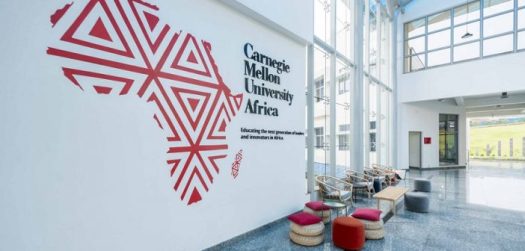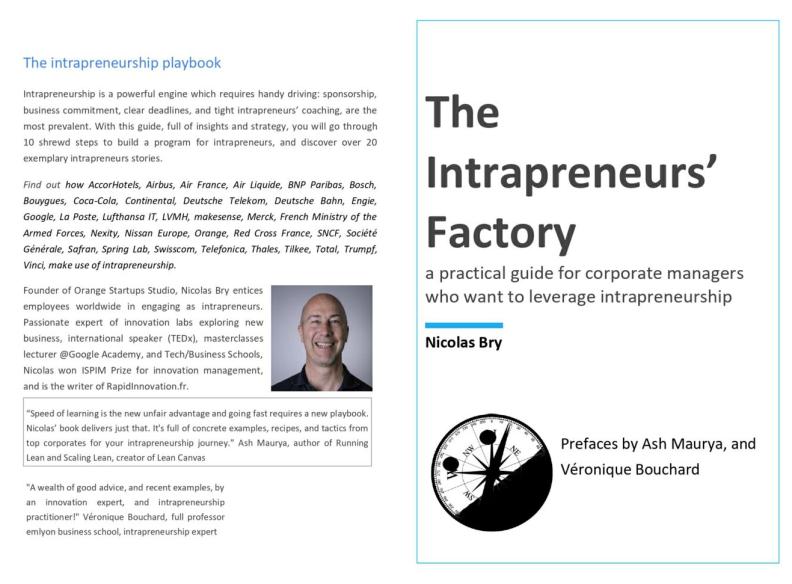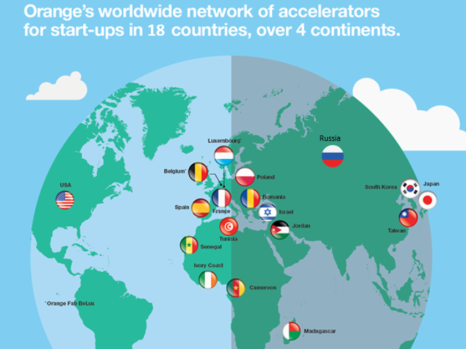Experimenting 100 innovative solutions over 20 countries in Africa
Experimenting 100 innovative solutions over 20 countries in Africa twice a year: that’s the process we describe in this compelling interview with David L. Ross, Innovation teacher at Carnegie Mellon University, about corporate open innovation in Africa, initially published in Disrupt Africa.
David Ross teaches innovation, entrepreneurship, and investment at Carnegie Mellon University Africa, and serves as the founding manager of the Industry Innovation Lab and managing director of Stratera Capital. He recently chatted with Nicolas Bry of Orange Africa about how to boost corporate open innovation initiatives in Africa.


Orange is a French multinational telecoms firm, with 266 million customers worldwide and operations in around 20 African countries. Bry serves as innovation booster for Orange Africa, and is author of the book “The Intrapreneurs’ Factory: A Practical Guide for Corporate Managers, to Leverage Intrapreneurship for Their Business, Their Employees, and the Greater Good”.
He and Ross discussed how to boost open innovation initiatives in Africa, involving internal startups as well as co-innovation with external startups.
Ross: “I’m very happy to speak in depth with Nicolas Bry, author of a great book on intrapreneurship. Can we begin with learning more about you and what you do at Orange?”
Bry: “I’m Innovation Booster for Orange Africa, which means helping our operations in 20 countries to generate, integrate, and distribute local innovations that solve problems and bring solutions to our customers across the African continent. It’s about sparkling bottom-up innovation, starting from the users pains, and expectations.
“It involves unearthing tangible projects, helping to implement and replicate them across the region, and supporting countries in setting up innovation organisations, and innovation enablers. A vivid community of 20 innovation champions is the armed wing to achieve this mission.”


Ross: “Can you share some of the lessons learned about what makes successful open innovation?”
Bry: “Before being innovation booster for Africa, I’ve created and been running the intrapreneurship programme at Orange for three and a half years, and throughout this I’ve met with many innovation managers and intrapreneurship managers. It gave me the idea to write a practical guide about intrapreneurship. In the book I cover the 10 steps for an innovation manager to build an intrapreneurship programme within their corporation, based on experiences from 40 different companies, and I included 20 stories of amazing intrapreneurs.


There are three key recommendations that emerge:
- Finding the right visible sponsor is crucial to success. Sometimes visible sponsors at the C-level won’t have time to support a startup or innovation, but he or she can appoint a deputy to work day to day with the startup;
- Innovation in short cycles is superior to long drawn out evaluations. Using the lean startup approach, test, learn, and iterate mindset, is also preferred in corporate problem solving as it maintains momentum, what I call “creative tension”;
- Integration is needed to gain traction. Solutions should be aligned with a business unit or functional area with a solution to a pressing problem that they have.
Alignment on these three areas will increase the chances of success for entrepreneurial pursuits.”
Ross: “That makes a lot of sense. What types of solutions are business units typically looking for in your experience?”
Bry: “There are four key areas that would attract a corporate business unit to want to collaborate with a startup, internal or external:
- Differentiation from competition – something that makes the corporate better than its competition in the eyes of the customers in the market;
- Market penetration – new products or services that increase revenue to the corporate, for example a telco providing a connectivity and mobile money solution to a new untapped market;
- Fear of disruption – something new that prevents the corporate from losing out on a big shift in the market or consumer preferences;
- Innovation theatre – the desire to look good Ross: “Thank you for those insights. How should a corporate evaluate new startups or innovations to work with?”
Bry: “Through exploration and experimentation. In typical exploration procedures, you collect ideas twice per year from business units, either internal ideas or ideas proposed from existing startups in a long list of up to 50 different innovations per country or entity. So 1,000 ideas in total across 20 countries. You narrow them down to 10 ideas per country and run a two-day dig-in workshop whose output is a value proposition, business model canvas, and some type of visualisation of the solution. At this stage, there is already a department or business unit sponsoring each of the 10 ideas.
“From there you narrow it down to five solutions per country and run an experimentation process. Experiments are not about building a product. You enrich the visualisation of the solution, then have meetings and interviews with prospective customers to see if the concept meets the market’s needs. Experiments with positive outcomes let you move further to exploitation and develop the solution in collaboration with the departments or business units, who then take full ownership.”


Ross: “That sounds like a mature repeatable process. Can innovations come from anywhere or internal only?”
Bry: “We follow an open innovation model so at the exploration stage an innovation can come from anywhere, and we welcome startups. The key requirement is that each solution needs to have a sponsor from a business unit or department.”
Ross: “How can entrepreneurs best approach Orange to consider collaboration?”
Bry: “One way is through our network of 18 Orange Fab Accelerators, which offer a three-month process where they’re connected to different business units within Orange. Another is in the market,


Ross: “Can you share a bit more about what those are and how entrepreneurs could benefit from them?”
Bry: “We have Application Program Interfaces (APIs) that is a programmatic way to interface with Orange like digital connectors. One difficulty of open innovation lies in the reluctance to share knowledge, or in implicit knowledge. APIs are a great way to foster open innovation as they’re like “explicit knowledge” that startups can access on a shelf. We have several types of APIs which can be found on our developer website.
Ross: “Thank you for that – I think more entrepreneurs should look into APIs available in their local markets to help create value for their startup ideas. Do you have any controversial advice for startups seeking to collaborate with corporates?”
Bry: “I would say that it’s better to create the desire as a pull than to sell your solution as a push. If an entrepreneur can create a buzz around their solution and gain the attention of the right people in a business unit, with a tailored B2B service, they’ll be able to move through the corporate procedures faster than if they’re trying to push something. So generating pull is preferable to pushing.”
